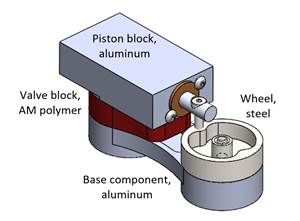Technology And Skill Are Keys To Mold Shop Success
The domestic die/mold industry is today going through considerable change-a good deal of which is being driven by an urgency to become more competitive coupled with advances in technology. Here's how one shop combines skill and technology to be more than just competitive, but to excel and grow.
Share




The domestic die/mold industry is today going through considerable change—a good deal of which is being driven by an urgency to become more competitive coupled with advances in technology. Here's how one shop combines skill and technology to be more than just competitive, but to excel and grow.
As one of three manufacturing companies under Laitram LLC, Intralox Inc. (Harahan, Louisiana) manufactures modular plastic conveyor belts. With more than 400 combinations of belt styles, materials and colors to offer, the company keeps its in-house mold shop running at full capacity.
Today, with 29 mold makers and repair technicians employing nine surface grinders, five milling machines, three ram and two wire EDM machines, the Intralox mold shop may well be one of the most competitive shops in the region. Aiding the company in this competition is the Jung J630-D with a PA/31 contour dresser with four diamond stations from United Grinding Technologies (Miamisburg, Ohio).
According to Jules Ceccanti, mold shop manager, the shop started out 10 years ago at Laitram as a mold repair facility. Then, as the repair activity continued, the decision was made to begin building mold cavities. As that capability grew, the company invested in more new technology, and today the mold shop is the predominant supplier of plastic injection molding tooling to the company.
"People who come here and see how we're set up and see the level of our technology, tell us that this mold shop is one of the best in the South," says Mr. Ceccanti.
The reasons that Intralox has its own mold shop are self-evident—the competitive advantage of fast time-to-market, the confidence that comes from complete process control and consistent product quality, and the ability to address the sensitive issue of the retaining of proprietary mold information. "If Intralox wanted to source its mold work outside," Mr. Ceccanti says, "it would be looking at 18- to 20-week leadtimes. We, however, can have a mold finished and producing good parts in 6 weeks, when we have to."
The shop does outsource some mold work. spreading it around. Some jobs, however, have proven too tough for others to tackle. "We used to bid out a couple of parts that we do very efficiently now on the Jung," Mr. Ceccanti says. "These parts are very complicated, highly detailed, time-consuming and very close-tolerance. Some shops just refused to quote; others bid high because they were either unsure if they could even make the part or unsure whether they could make a profit on the job."
There were two of these parts, Mr. Ceccanti says, that he got bids of $1,750 per part. With the Jung, his team makes the parts for $400 each.
Shane Jackson, lead mold maker, addresses some of the reasons the J630-D was acquired. "Our previous CNC machine could do just about everything we wanted, but there were some limitations" he says. The diamond dressers were stationary, which meant the machine had to travel X, Y and Z to the dress wheel, which tended to create flat spots, spots where parts of the diamond surface are worn more than others. When we'd start getting spotty diamond wear, the machine operator would try to compensate for it, but the compensation just wasn't accurate enough."
The CNC dresser on the Jung rotates about an axis and permits much more controlled diamond wear. Further, if a certain section of the diamond begins to wear, Mr. Jackson says, you can change the angle where the diamond and the wheel intersect, thus avoiding the worn section and using more of the diamond. The rotational four-diamond dresser avoids diamond wear, and the Jung permits continuous dressing so that dressing and grinding can occur simultaneously.
Mr. Jackson says that with the previous method, he'd have to draw all the wheel geometry, post it through a software program, and then download it to the machine. With the Jung, however, he simply takes a DXF file from the designer, plugs it into the J630-D and runs the wheel profile right from the file.
A resident wheel library facilitates quick setup. Mr. Jackson explains that the Jung actually "remembers" wheel shapes. "You take the wheel off and store it away, but the wheel information stays in the machine's library. Then, when you put the wheel back on, you type in a library number, and the Jung knows what the wheel shape was the last time it was used. This is a great feature, permitting the flexibility to interrupt a job, run a new job or several jobs and then go back to the original job with no complicated reprogramming or setup issues—even if a month has passed between jobs."
Mr. Jackson says the Jung is used for the shops most critical work, work in tough materials with very tight tolerances and requiring superior surface finishes. One example is special core pin slots, which are roughly 0.2000 inch deep by 0.4000 inch wide by 12 inches long in a cavity block that's 12 inches by 2 inches and 2 inches thick. Typical material is 420 stainless or Elmax, a powder metallurgical high vanadium version of 420 that's comparable to D2 and is one of the most difficult materials to grind. 420 is generally 50-52 Rc, and Elmax is 58-62 Rc.
Once a cavity block has been squared up and sized, it will come to the Jung, where Mr. Jackson will load the wheel geometry, radii and angles, wheel manufacturer, wheel type, grit size, and so on into the wheel library. He's then ready to dress the form.
"After I've dressed the form," Mr. Jackson says, "I'll qualify it by grinding the form in graphite. Then, I'll pull the graphite and inspect it using conventional means—comparators, indicators or a Zeiss CMM—to inspect and check the contour or axis of the radius. Generally, on forms we hold ±0.0002 inch. If the graphite checks out, I know the wheel geometry is fine. Then I'll touch on either side of the block, find the center, calculate my locations—typically I'll program to location and depth—and then run the part. And the part is right on size, without running any test work."
"Typically, in mold making, you cut some and then you measure; then you cut some more and measure some more," he says. "As you get closer and closer to your final dimensions, you're measuring more and cutting less. With the Jung, once the wheel geometry is correct, you measure once and cut straight to dimension."
The result is a significant savings in time, as well as an increase in productivity and flexibility. Mr. Jackson cites a couple of examples. Before the Jung, it would take a full day to run four to five typical 8 inch by 10 inch cavities with four core slots. With the Jung, he can set up the same job and run production—all before noon.
"Start to finish, it would take us two full 10-hour days to run six cavities before the Jung. Now six cavities are done in a day," Mr. Jackson says. "That's a time savings of 50 percent. It's not that the Jung grinds any faster; it's in setup time and measuring time where we see the real competitive benefits."
One of the crucial issues in die/mold work is having complete confidence in your tools—especially the grinder. "You have to build up a level of trust in the machine," Mr. Jackson says. "Manual machines, for example, are notorious for creeping, for getting a lot of wheel wear and not knowing exactly where the wear is."
However, he says he doesn't worry about the J630-D and its rotating four diamond dresser. The PA/31 rotates through each of the four diamonds—a rough diamond, a semi-rough diamond, a finish diamond and an idle diamond. The idle diamond takes a zero pass all the way through the form, ensuring that if any flat spots remained after the three previous passes, the idle diamond will pick them up.
Mr. Jackson says that to compete today, manufacturers have to use machines that provide high productivity and flawless accuracy. Successful mold shops, have to be able to convert their operations to high-end, high-productivity, high-accuracy technology.
Related Content
Solve Worker Shortages With ACE Workforce Development
The America’s Cutting Edge (ACE) program is addressing the current shortage in trained and available workers by offering no-cost online and in-person training opportunities in CNC machining and metrology.
Read MoreHow to Pass the Job Interview as an Employer
Job interviews are a two-way street. Follow these tips to make a good impression on your potential future workforce.
Read MoreDN Solutions Responds to Labor Shortages, Reshoring, the Automotive Industry and More
At its first in-person DIMF since 2019, DN Solutions showcased a range of new technologies, from automation to machine tools to software. President WJ Kim explains how these products are responses to changes within the company and the manufacturing industry as a whole.
Read MoreInside Machineosaurus: Unique Job Shop with Dinosaur-Named CNC Machines, Four-Day Workweek & High-Precision Machining
Take a tour of Machineosaurus, a Massachusetts machine shop where every CNC machine is named after a dinosaur!
Read MoreRead Next
5 Rules of Thumb for Buying CNC Machine Tools
Use these tips to carefully plan your machine tool purchases and to avoid regretting your decision later.
Read MoreRegistration Now Open for the Precision Machining Technology Show (PMTS) 2025
The precision machining industry’s premier event returns to Cleveland, OH, April 1-3.
Read MoreBuilding Out a Foundation for Student Machinists
Autodesk and Haas have teamed up to produce an introductory course for students that covers the basics of CAD, CAM and CNC while providing them with a portfolio part.
Read More





























.jpg;maxWidth=300;quality=90)








